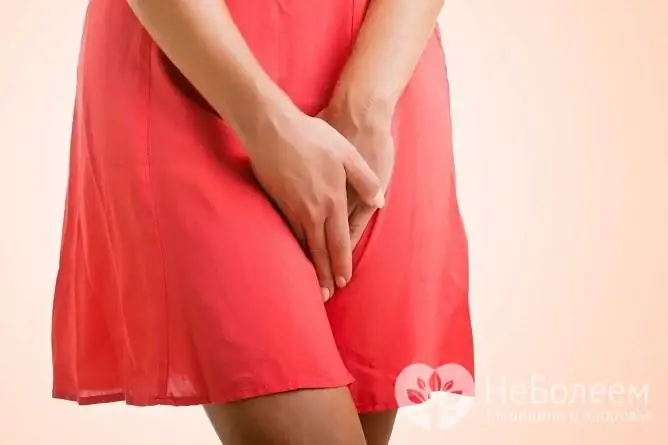- Author Rachel Wainwright [email protected].
- Public 2023-12-15 07:39.
- Last modified 2025-11-02 20:14.
Urinary incontinence in women when coughing and sneezing
The content of the article:
- Description of the problem
-
The reasons
- Operations on the pelvic organs
- Traumatic childbirth
- Climacteric syndrome
- Damage to the nervous system
- Concomitant pathology
- When to see a doctor
-
How to treat incontinence
- What can be done at home
- Gymnastics
- Operative intervention
- Folk remedies
- Hygiene
- Video
Urinary incontinence in women when coughing and sneezing creates a lot of inconvenience. The problem prevents a woman from feeling confident and reduces her quality of life. You can get rid of the uncomfortable phenomenon - for this, conservative therapy is used, and if it does not help, then surgical intervention.

Women suffer from stress urinary incontinence; in men, this pathology practically does not occur
Description of the problem
Women often experience stress urinary incontinence, a pathology that hardly occurs among men. This is because women have weaker pelvic floor muscles, which is a risk factor for incontinence. With age, the disease is more common.
Stress urinary incontinence occurs with a sharp increase in intra-abdominal pressure. For example, during:
- cough;
- sneezing;
- laughter;
- lifting weights;
- physical activity.
In such cases, a small amount of urine (urine) is released. In this case, there is no urge to urinate or discomfort.
In this state, a woman is afraid to laugh too hard, cough or sneeze, lift something heavier than the usual norm. Urinary incontinence is associated with tightness, discomfort, and shame. Often, a woman is haunted by the smell of urine released during the day.
The reasons
The main cause of urinary incontinence is weakness of the pelvic floor muscles or damage to connective tissue structures. This is possible with damage to the birth canal, after surgery on the pelvic organs, during menopause or damage to the nervous system. A concomitant pathology plays a certain role in the development of urinary incontinence: obesity, constipation, diabetes mellitus.
Operations on the pelvic organs
Urinary incontinence is often a complication of pelvic and perineal surgery. The reason for this complication is damage to the ligamentous apparatus during surgery. The risk is especially high when the uterus is removed.
Traumatic childbirth
Damage to the tissues of the birth canal during labor can also cause urinary disorders. Pathology is often observed with a large weight of the child, obstetric operations, weakness of labor.
Climacteric syndrome
Stress urinary incontinence in women often develops during menopause. This is due to a deficiency of estrogen in a woman's body. Lack of estrogen leads to degeneration of the connective tissue of the urogenital tract.
Coughing, laughing, sneezing, and straining increase pressure on the bladder, which leads to urinary incontinence.
Damage to the nervous system
Another reason why urinary incontinence develops is damage to the brain or spinal cord. Damage to urinary centers or nerve fibers leads to involuntary flow of urine during coughing, sneezing, or exercise.
Diseases that can lead to impaired urination:
- cerebral atherosclerosis;
- stroke;
- damage to blood vessels and nerves in diabetes mellitus;
- traumatic brain injury or spinal injury.
Concomitant pathology
The genetic factor also plays a role in the development of urination disorders. With a hereditary predisposition to weakness of the connective tissue, the disease develops several times more often.
Other diseases that cause incontinence:
- Overweight. With obesity, the tone of the bladder is weakened, which leads to involuntary urination.
- Constipation. Persistent constipation leads to increased intra-abdominal pressure.
- Chronic cough. In diseases that are manifested by chronic cough, an increase in intra-abdominal pressure is also observed.
When to see a doctor
Stress urinary incontinence is primarily a social rather than medical problem. The disease does not pose a particular danger to human health.
With a problem, you can contact your family doctor, gynecologist or urologist. If necessary, the doctor will conduct an additional examination:
| Research method | Indications for appointment, description of results |
| Cough test |
It is prescribed in all cases of urinary incontinence. With stress incontinence, the cough test is positive - when coughing, a small amount of urine is released. |
| General urine analysis |
To exclude inflammation of the bladder (cystitis). With cystitis, leukocytes and bacteria will be detected in the urine. With stress urinary incontinence, there will be no signs of inflammation. |
| Examination in gynecological mirrors | The cause of persistent urine discharge may be the presence of a vesicovaginal fistula. The method is used to exclude this condition. |
Stress incontinence is indicated by the appearance of a symptom when coughing, sneezing, or lifting a weight. A prerequisite is the absence of the urge to urinate, incontinence at rest.

Special urological pads can solve the hygiene problem of stress incontinence
How to treat incontinence
Treatment of stress urinary incontinence is provided by an integrated approach. Lifestyle correction, diet therapy, gymnastics and Kegel exercises are used. In severe cases and with the ineffectiveness of conservative methods, an operation is indicated.
What can be done at home
General recommendations for involuntary discharge of urine:
- Don't drink a lot of fluids before bed.
- Eliminate caffeine and alcoholic beverages from your diet.
- Avoid eating spicy and acidic foods that irritate the bladder.
- Watch your diet: Eliminate foods that slow down intestinal motility and provoke constipation from the diet.
- Eliminate strenuous physical activity.
- Normalize body weight - obesity puts additional stress on the bladder.
Compliance with these recommendations will help get rid of urinary disorders with mild severity.
Gymnastics
The most effective and important early treatment for incontinence is gymnastics.
Kegel exercises are the most effective for urinary incontinence. Before you start gymnastics, you need to identify the muscles of the perineum. This is done in the following way: you need to sit on the toilet, urinate and try to stop the flow of urine. The muscles that tense at the same time are the muscles of the perineum, they will be involved in the exercise.
Kegel exercises consist of 3 parts:
- Slow compressions. Tighten your perineal muscles, count to three, and then relax.
- Abbreviations. At a fast pace, tense and relax the muscles of the perineum.
- Ejection. Push as during childbirth or defecation, using the muscles of the perineum.
You need to start training gradually: 10 slow squeezes, 10 contractions, 10 push-ups. You should gradually increase the pace, adding 5 repetitions to each exercise.
Operative intervention
The operation is indicated in cases where conservative treatment has not helped. It is not recommended to start immediately with the operation.
A loop is placed under the middle part of the urethra, thanks to which the urine is held and does not leak. The operation is performed under general anesthesia. The surgeon makes small incisions in the vagina and groin and places a loop made of synthetic mesh made from prolene.
After the operation, incontinence during coughing disappears, relapses occur extremely rarely - no more than 5% of cases.
Folk remedies
Folk remedies for urinary incontinence are ineffective. It is impossible to strengthen the muscles of the pelvic floor with the help of medicinal herbs and food.
Folk remedies can be used only for preventive purposes:
- For the prevention of inflammation. Decoctions of chamomile, calendula are used. Both local and internal application is possible.
- For the prevention of constipation. Leaves of nettle, yarrow, buckthorn are used. Decoctions and infusions are prepared from herbs, which are taken orally.
Hygiene
You can cope with the symptom with urological pads. They are used to neutralize odors and absorb urine. The use of pads is only a measure of hygiene, it will not relieve the disease.
Video
We offer for viewing a video on the topic of the article.

Anna Kozlova Medical journalist About the author
Education: Rostov State Medical University, specialty "General Medicine".
Found a mistake in the text? Select it and press Ctrl + Enter.






